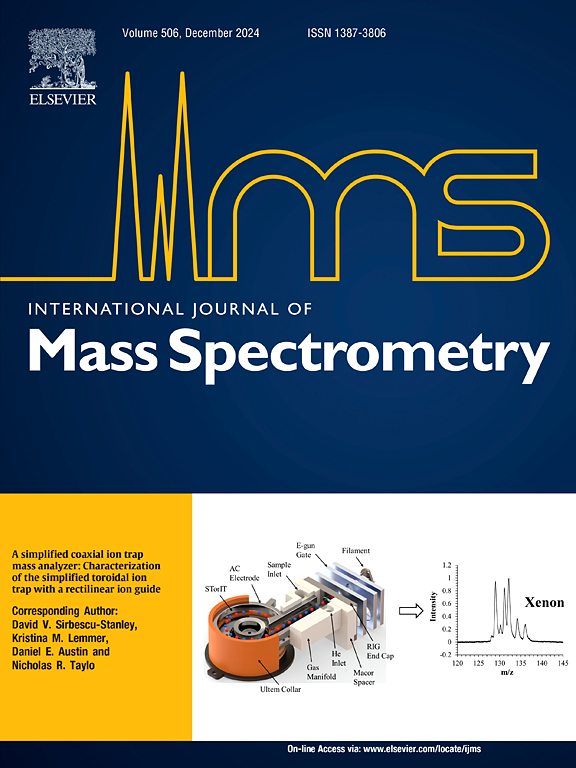Plasmid-encoded gene expression of pathogenic bacteria by antibiotic induction as detected by MALDI-TOF-TOF mass spectrometry and top-down proteomic analysis
IF 1.7
3区 化学
Q3 PHYSICS, ATOMIC, MOLECULAR & CHEMICAL
引用次数: 0
Abstract
Three previously genomically sequenced Shiga toxin-producing E. coli (STEC) strains of serotypes O43:H2, O103:H11, O111:H8 were analyzed by antibiotic induction, MALDI-TOF-TOF mass spectrometry and top-down proteomic analysis. In addition to detection and identification of phage-encoded Shiga toxin, we identified plasmid-encoded immunity proteins for colicin E8 and colicin D. Protein biomarkers were identified from b- and y-type fragment ions generated by the aspartic acid effect (AAE) that favors backbone cleavage on the C-terminal side of aspartic acid (D), glutamic acid (E) and asparagine (N) residues. Our in-house software was used for protein biomarker identification. Consistent with our previous report, we observed an apparent enhancement of the AAE when the residue on the C-terminal side of D-, E− or N-residues is a glycine (G). In silico predicted protein structures revealed that these DG, EG, NG sites of backbone breakage often correspond to flexible linker regions of the backbone. Finally, each pathogenic strain carried one or more large plasmids as well as a 6–8 kb plasmid that contained the colicin gene and its cognate immunity gene. Immediately upstream of the colicin gene was an SOS/LexA box to which the repressor protein (LexA) binds and blocks expression of genes downstream. Upon initiation of the SOS response by antibiotic induction, LexA undergoes self-cleavage and detachment allowing downstream gene expression. Thus, the presence of these small plasmids, their genes and the mechanism of expression is consistent with antibiotic induction and top-down proteomic analysis.

MALDI-TOF-TOF质谱法和自上而下蛋白质组学分析检测抗生素诱导致病菌的质粒编码基因表达
采用抗生素诱导、MALDI-TOF-TOF质谱和自上而下的蛋白质组学分析,对3株产志贺毒素大肠杆菌(STEC)血清型O43:H2、O103:H11、O111:H8进行了基因组测序。除了检测和鉴定噬菌体编码的志贺毒素外,我们还鉴定了质粒编码的colicin E8和colicin D免疫蛋白。蛋白质生物标志物是从天冬氨酸效应(AAE)产生的b型和y型片段离子中鉴定出来的,这些片段离子有利于天冬氨酸(D)、谷氨酸(E)和天冬酰胺(N)残基c端主干的切割。我们的内部软件用于蛋白质生物标志物鉴定。与我们之前的报道一致,我们观察到当D-, E -或n -残基的c端残基是甘氨酸(G)时,AAE明显增强。计算机预测的蛋白质结构显示,这些DG, EG, NG位点的骨干断裂通常对应于骨干的柔性连接区域。最后,每个致病菌株携带一个或多个大质粒以及一个6-8 kb的质粒,其中含有大肠杆菌素基因及其同源免疫基因。紧靠colicin基因的上游是一个SOS/LexA盒子,抑制蛋白(LexA)结合并阻断下游基因的表达。在抗生素诱导的SOS反应启动后,LexA经历自裂和脱离,允许下游基因表达。因此,这些小质粒及其基因和表达机制的存在与抗生素诱导和自上而下的蛋白质组学分析是一致的。
本文章由计算机程序翻译,如有差异,请以英文原文为准。
求助全文
约1分钟内获得全文
求助全文
来源期刊
CiteScore
3.60
自引率
5.60%
发文量
145
审稿时长
71 days
期刊介绍:
The journal invites papers that advance the field of mass spectrometry by exploring fundamental aspects of ion processes using both the experimental and theoretical approaches, developing new instrumentation and experimental strategies for chemical analysis using mass spectrometry, developing new computational strategies for data interpretation and integration, reporting new applications of mass spectrometry and hyphenated techniques in biology, chemistry, geology, and physics.
Papers, in which standard mass spectrometry techniques are used for analysis will not be considered.
IJMS publishes full-length articles, short communications, reviews, and feature articles including young scientist features.

 求助内容:
求助内容: 应助结果提醒方式:
应助结果提醒方式:


